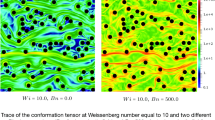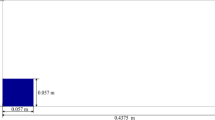Abstract
Flow front advancement is a common phenomenon in many industrial process simulations, which are important in designing tools for these processes. The advancement is traditionally simulated by performing numerical computation in a meshed flow domain with a known velocity field. Since the design process is iterative, the costs of performing detail simulation in all iterations are high. This paper presents a meshless approach to simulate the flow front advancement in a bounded domain. The computation efficiency of this approach is raised because part of it is handled by a solid geometry kernel and the costs are further reduced by an estimated the velocity field. The generated flow front pattern is useful in preliminary analysis. An engineering example in injection moulding is raised to demonstrate the application.
Similar content being viewed by others
References
Au CK (2005) A geometric approach for injection moulding filling simulation. Int J Mach Tool Manuf 45(1):115–124
Martinez MA, Cueto E, Alfaro I, Doblare M, Chinesta F (2004) Updated Lagrangian free surface flow simulations with natural neighbour Galerkin methods. Int J Numer Methods Fluids 60(12):2105–2129
Tadmor Z, Broyer E, Gutfinger C (1974) Flow analysis network (FAN)-A method for solving flow problems in polymer processing. Polymer Eng Sci 14:660–665
Broyer E, Gutfinger C, Tadmor Z (1975) A theoretical model for the cavity filling process in injection molding. Trans Soc Rheology 19:423–444
Kietzmann CVL, Van Der Wal JP, Morsi YS (1998) A free-front tracking algorithm for a control-volume-based Hele-Shaw method. Int J Numer Methods Eng 42:253–269
Hirt CW, Nichols BD (1981) Volume of fluid (VOF) method for the dynamics of free boundaries. J Comput Phys 39:201–225
Thompson E (1986) Use of pseudo-concentration to follow creeping viscous flows during transient analysis. Int J Numer Methods Fluids 6:749–761
Chang R, Yang W (2001) Numerical simulation of mold filling in injection molding using a three-dimensional finite volume approach. Int J Numer Methods Fluids 37(2):125–148
Sethian JA, Vladimirsky A (2000) Fast methods for the Eikonal and related Hamilton- Jacobi equations on unstructured meshes. PNAS 97(11):5699–5703
Sethian JA (1996) A fast marching level set method for monotonically advancing fronts. PNAS 93(4):1591–1595
Hetu JF, Gao DM, Kabanemi KK, Bergeron S, Nguyen KT, Loong CA (1998) Numerical modeling of casting processes. Adv Performance Mater 5:65–82
O’Rourke J (1998) Computational Geometric in C, 2nd edn. Cambridge University Press
Mantyla M (1988) An introduction to solid modeling. Computer Science Press, Rockville, MD
Menges G, Michaeli W, Mohren P (2001) How to make injection molds. Hanser, Munich
Sethian JA (1999) Level set methods and fast marching methods evolving interfaces in computational geometry, fluid mechanics, computer Vision, and materials science. Cambridge University Press
Crandall MG, Evans LC, Lions PL (1984) Some properties of viscosity solutions of Hamilton-Jacobi equations. Trans Am Math Soc 282:487–502
Author information
Authors and Affiliations
Corresponding author
Rights and permissions
About this article
Cite this article
Au, C.K. A meshless method for predicting two dimensional flow front advancement and its application in injection moulding. Int J Adv Manuf Technol 34, 62–69 (2007). https://doi.org/10.1007/s00170-006-0566-7
Received:
Accepted:
Published:
Issue Date:
DOI: https://doi.org/10.1007/s00170-006-0566-7




